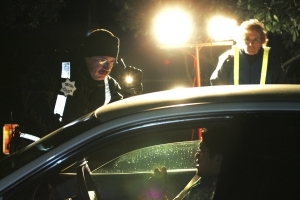State and local law-enforcement officials on Wednesday kicked off a public awareness campaign about the dangers of stoned driving just days before retail marijuana will be legally available for sale across the state.
Officials from the California Highway Patrol and the Sacramento Police Department joined other agencies, including the National Highway Traffic Safety Administration, on the steps of the Capitol to unveil the campaign, which is called “DUI Doesn’t Just Mean Booze.”
California voters approved the sale of retail marijuana in November 2016. Cannabis sales will become legal for adults 21 and older starting Jan. 1.
The public awareness campaign comes days after a CHP officer was killed by a 22-year-old motorist who was allegedly drunk and high on marijuana when he slammed into the officer’s patrol vehicle on a Bay Area highway. The CHP held a bell-ringing “end of watch” memorial for Officer Andrew Camilleri in West Sacramento on Wednesday.
“Most people know driving drunk is dangerous,” said Rhonda Craft, director of the California Office of Traffic Safety, which is leading the campaign. “What they may not know is that you can get a DUI … while driving high.”
Incidents of driving under the influence of marijuana increased when Colorado legalized recreational pot in 2014, she said.
“We expect an increase in accidents here,” she said, adding that marijuana can slow reaction times when drivers may need to make life-saving decisions.
According to statistics from the Colorado Department of Transportation, marijuana-involved traffic fatalities went from 55 in 2013 to 79 the first year of legalization. They have continued to rise, up to 125 this past year.
In addition to the public awareness campaign, California law-enforcement officials have increased training for officers to learn how to recognize drug impairment in drivers.
Currently, law enforcement doesn’t have a test to measure marijuana-impaired driving with the precision of the blood-alcohol test used to gauge drunken driving. While tests can measure the presence of THC, an active compound in marijuana, in a person’s system, they can’t determine if the levels impaired the driver when stopped by an officer.
As a result, officers are trained to use field-sobriety tests, in combination with THC-measurement tests, to determine impaired driving, said Lt. Eric Jones of the CHP.
CHP has been providing drug recognition education, a 72-hour classroom course, to officers across the state, including those at other law-enforcement agencies.
Drugged driving isn’t a new problem, as CHP has responded to numerous incidents since medical marijuana was legalized in California 20 years ago, Jones said.
CHP also is working with researchers at the University of California, San Diego, to improve testing for drugged driving. The university has employed driving simulators used by people on marijuana to measure the drug’s effect on driving and to come up with better ways of measuring impairment.
Dale Gieringer, director of California NORML, a marijuana advocacy group, said he supports the current approach the state is taking. He said the CHP and other agencies have done a good job of enforcing DUI laws, as indicated by the fact that total DUI arrests this past year were at their lowest point in more than a decade.
He said NORML would oppose any laws that try to set THC limits in a similar fashion as blood-alcohol levels. He said Washington state approved such a law, and lawmakers have considered a similar one in California, even though a person can have THC in his or her system days or weeks after consuming marijuana.
“Was the person impaired?” he said. “There are no drug tests that can tell us that.”
credit:msn.com


